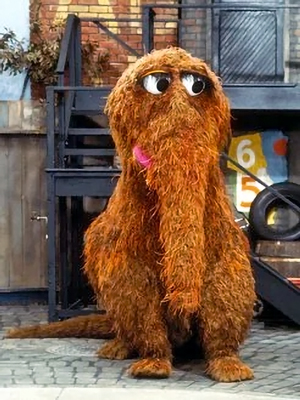Animalia Chordata Mammalia Proboscidea Elephantidae Mammuthus Snuffleupagus
Anatomy and Physiology:
Built like a tuskless, earless woolly mammoth, the Snuffleupagus is covered in a thick coat of long, brown fur, with long eyelashes. The girth of the beast is so immense that its stomach barely touches the ground when it stands on all fours. Years of evolution have causes its legs to become stubby, shortened by the amount of weight it carries.
A young healthy male Snuffleupagus
Due to its large mass, the Snuffleupagus lacks agility. It relies on its trunk (called a "snuffle") to hande quick movements and picking up objects. Like any member of the elephant family, it can store fluids and gases in its snuffle.
The first appearance of a Snuffleupagus, during it's prepubescent "wild, yellow-eyed" stage.
Because the snuffle receives the most action on a daily basis, special exercises are required to keep their snuffle in fit shape. This is known as the "Snuffle Shuffle."
Discovery:
Snuffleupaguses were once thought to be mythical creatures. For many years, no one had ever seen a Snuffleupagus in the flesh. The only record of the existence of a Snuffleupagus was based on ancient Hawaiian legends about Mount Ihu Papa'a Lo'ihi Nui, a.k.a. Mt. Snuffleupagus due to its shape resembling that of the sleeping beast. The original tale can be heard here.
The resemblance is uncanny.
It was not until the 1970s when a young bird first discovered one of these creatures living on Sesame Street. For many years, no one believed his stories, but eventually everyone was made aware of the presence of this species that was once thought to have been extinct.
Habitat:
Big Bird's discovery led to the revealing of an entire colony of Snuffleupaguses that lived in caves, which were a six day hike from Sesame Street. It is unclear how this current population of Snuffleupaguses managed to get from the islands of Hawaii to New York, but cartographers have noticed an intricate system of tunnels connecting all Snuffleupagus caves, which could explain the reappearance of the species halfway across the world.
A mother and her child inside a cave.
Behavior:
The Snuffleupagus speaks very slowly, which is often misattributed to depression and a negative attitude. Snuffleupaguses can be very paricular and must make sure they are completely ready behore making major or minor life changes. This can result in missed opportunities and other setbacks when complied with the slow nature of the Snuffleupagus's body.
Also, they require a large amount of sleep, which adds to their perpetual grogginess.
Other than their animal appearance and cavernous habitats, Snuffleupaguses behave just like humans. The behavior of infant Snuffleupaguses is not far removed from human toddlers.
Baby Alice learns the alphabet from her older brother Aloysius (Snuffy).
Their life cycle is so similar to ours that one may infer that these creatures followed a similar evolutionary path as humans, due to living in close quarters with them. The reason for their mysterious disappearance for centuries can be ascribed to the long migratory journey they took through the Earth. As their mammoth cousins died out, the Snuffleupaguses stayed warm underground, awaiting the day they felt it was safe to surface.
Although it seems impossible, these creatures do exist and have a deep history waiting to be told.




No comments:
Post a Comment